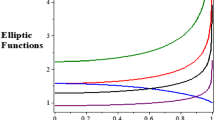Abstract
This paper proposes the semispectral method for the calculation of the scattering matrices for the charge carriers in quasi-one-dimensional quantum systems described by the Schrodinger equation. An efficient and accurate calculation method is achieved by adding of reference solutions at selected energy points to the eigenfunction expansion of the Green’s function. A numerical simulation of the quantum wire with the square cross-section in transverse electric field was performed by different methods. The example problem of a quantum wire in a transverse electric field is used to compare the semispectral method with alternative approaches. We find that the semispectral method reliably converges and is significantly faster than the direct solution while the eigenfunction expansion approach has convergence issues. These results allow us to propose the semispectral method as a universal and efficient approach to calculation of the transmission coefficients for the Landauer formula as well as other scattering-based entities.






Similar content being viewed by others
References
Landauer, R.: Spatial variation of currents and fields due to localized scatterers in metallic conduction. IBM J. Res. Dev 1(3), 223–231 (1957)
Buttiker, M., Imry, Y., Landauer, R., Pinhas, S.: Generalized many-channel conductance formula with application to small rings. Phys. Rev. B 31(10), 6207–6215 (1985)
Fisher, D., Lee, P.: Relation between conductivity and transmission matrix. Phys. Rev. B 23(12), 6851–6854 (1981)
Langreth, D., Abrahams, E.: Derivation of Landauer conductance formula. Phys. Rev. B 24(6), 2978 (1981)
Tsurikov, D.E., Yafyasov, A.M.: Logical element NOT in a two-dimensional electron waveguide. Tech. Phys. 56(9), 1231–1234 (2011)
Goncharov L. I.: Precision analysis for numeric calculation of the S-matrix for a quantum network element via DN-map and ND-map. In: Proceedings of the conference ‘Physics and Progress‘, GIGABYTE Technology, St. Petersburg, 184–188 (2009) in Russian
Racec P. N., Racec E. R., Neidhardt H.: R-matrix formalism for electron scattering in two dimensions. arXiv:0910.5846 [cond-mat.mes-hall], (2009)
Wulf, U., Kucera, J., Racec, P.N., Sigmund, E.: Transport through quantum systems in the R-matrix formalism. Phys. Rev. B 58(24), 16209–16220 (1998)
Pavlov, B.: S-matrix and Dirichlet-to-Neumann operators. In: Pike, R., Sabatier, P. (eds.) Encyclopedia of Scattering, pp. 1678–1688. Harcourt Science and Tech. Company, Academic Press, Orlando (2001)
Blakemore, J.S.: Semiconducting and other major properties of gallium arsenide. J. Appl. Phys. 53, R123–R181 (1982)
Racec, P.N., Racec, E.R., Neidhardt, H.: Evanescent channels and scattering in cylindrical nanowire heterostructures. Phys. Rev. B 79, 155305 (2009)
Martin, G., Yafyasov, A.M., Pavlov, B.S.: Resonance one-body scattering on a junction. Nanosystems 1, 108–147 (2010)
Acknowledgments
Authors would like to thank Dr. Joseph C. Doll for his remarks and corrections that helped to make this paper more consistent.
Author information
Authors and Affiliations
Corresponding author
Appendix
Appendix
To obtain formula (13), that links the DN-map operator and the scattering matrix, consider formula (5) with the new notations
And consider two representations for the normal derivative of the wavefunction on the interfaces \(\Gamma _{I}\) and \(\Gamma _{III}\). The first one is based on (5)
The second is based on the definition of the DN-map operator (9)
Here \(\psi _n^r \) is a projection of the wavefunction \(\psi ^{r}\) onto the n’s channel.
Since the wavefunction and its first derivative should be continuous, both expressions (33) and (34) are equal.
After some reordering and switch to the operator form (33) turns into
These two expressions can be combined into one, using matrix notation
The elements of the operator K with differing upper indices are zero, so K\(^{\mathrm{I,III}}\) and K\(^{\mathrm{III,I}}\) are the zero operators. This fact allows us to note (37) in the following form
And finally,
Rights and permissions
About this article
Cite this article
Goncharov, L.I., Yafyasov, A.M. & Tsurikov, D.E. A semispectral approach for the efficient calculation of scattering matrices in quasi-1D quantum systems and transmission coefficients for the Landauer formula. J Comput Electron 13, 885–893 (2014). https://doi.org/10.1007/s10825-014-0605-9
Published:
Issue Date:
DOI: https://doi.org/10.1007/s10825-014-0605-9




